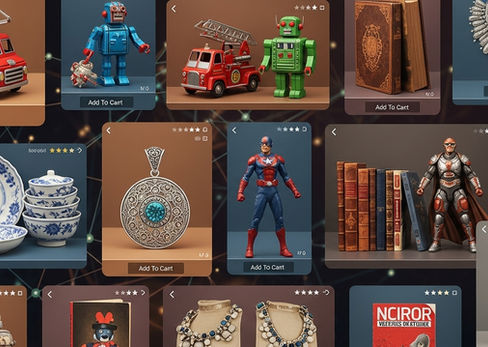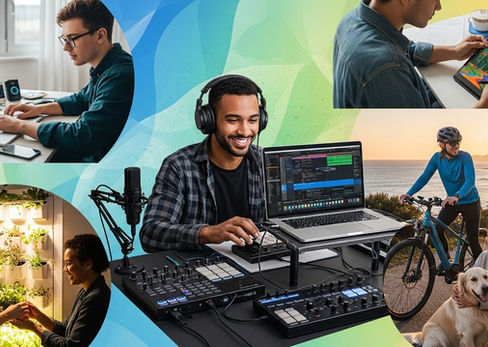Nano Banana 3D Figurines: How AI-Powered Miniatures Are Redefining Visual Art
- THE MAG POST

- Sep 13
- 6 min read

Nano Banana 3D figurines are transforming casual photos into tangible-looking miniatures at an astonishing pace. As AI-driven tools like Gemini 2.5 Flash Image become accessible, creators across ages are sketching new lines between imagination and craft. This piece examines what the trend reveals about creativity, platforms, and digital culture.
From celebrity posts to hobbyist prompts, the movement blends free utility with social validation, turning everyday moments into shareable artifacts that travel across feeds. We’ll explore benefits, pitfalls, and best practices for creators and platforms navigating this evolving AI-enabled art frontier.
Nano Banana 3D Figurines: A New Era of AI-Driven Miniatures
AI-powered miniatures are no longer niche experiments but everyday creative tools that captivate millions. The Nano Banana 3D Figurines phenomenon shows how accessible technology reshapes visual storytelling and personal branding across social feeds.
Accessibility and Free Use
One core strength of Nano Banana 3D figurines is their accessibility. The platform is free, browser-based, and forgiving for beginners, which lowers the barriers to entry for artists, students, and hobbyists alike. This democratization invites experimentation without the need for expensive software or specialized training.
As usage grows, platforms also need to address licensing, attribution, and fair use. The lack of upfront barriers can lead to inconsistent outputs, which means creators should document their processes and share clear notes about rights and provenance when publishing finished figurines.
Hyper-Realistic Output and Limits
Hyper realism is the hallmark of Nano Banana outputs, yet the process reveals constraints. Outputs depend on image quality, input prompts, and lighting, which can produce surprising artifacts or misalignments. Users learn to iterate carefully, refining prompts and angles to coax believable textures, fabrics, and environmental cues.
Despite impressive fidelity, there is a learning curve, and results may vary across devices or browser environments. The speed advantage invites experimentation but also pressure to post quickly. Smart practitioners document their methods, manage expectations, and curate prompts that minimize bias while maximizing visual coherence and storytelling potential.
Celebrity Buzz and Everyday Creativity
Celebrity buzz has turned a quirky tool into a cultural moment, expanding the reach of AI-generated miniatures beyond early adopters. When high-profile posts circulate, followers imitate, remix, and experiment with subjects ranging from pets to iconic characters, expanding the ecosystem in surprisingly rapid ways.
Public Figures and Social Proof
Public figures and fan accounts amplifying Nano Banana 3D figurines create social proof that accelerates participation. When influencers share quick previews, their audiences imitate styles, refine prompts, and experiment with subjects from pets to iconic characters. The ripple effect converts a niche feature into a mainstream conversation.
Beyond celebrities, everyday creators use prompts to craft personal keepsakes, mascots, and playful tributes, turning a hobby into a public, collaborative project. This democratization of design invites discussions about authorship, originality, and the evolving nature of digital provenance.
Community and Pet Figurines
Pet owners are adopting the trend to celebrate companions with textures capturing fur, eyes, and tiny accessories with surprising fidelity. The ability to tailor scales and poses makes the outputs feel intimate, like a personalized desk gallery where each figurine tells a small story.
Communities also discuss ethics and attribution; sharing tips fosters trust and ensures longevity of the trend. As prompts and layouts circulate, best practices emerge for image quality, respectful prompts, and clear provenance notes that help sustain constructive exchange.
Guided Creation: Steps with Google AI Studio
Getting started is straightforward, but momentum comes from thoughtful prompts and careful asset choices. The Google AI Studio interface guides newcomers through uploading a photo, selecting Nano Banana, and refining the result into a lifelike miniature that fits neatly on a desk or shelf.
From there, creators build a toolkit of prompts, lighting setups, and prop ideas. Documenting versions, saving iterations, and sharing final shots helps others learn faster and minimizes the trial-and-error fatigue that often accompanies early experiments.
Getting Started
Getting started is straightforward, but momentum comes from thoughtful prompts and careful asset choices. The Google AI Studio interface guides newcomers through uploading a photo, selecting Nano Banana, and refining the result into a lifelike miniature that fits neatly on a desk or shelf.
From there, creators build a toolkit of prompts, lighting setups, and prop ideas. Documenting versions, saving iterations, and sharing final shots helps others learn faster and minimizes the trial-and-error fatigue that often accompanies early experiments.
Crafting Effective Prompts
Precise prompts drive realism: specify scale, clothing details, textures, and background context. A well-phrased prompt can evoke metallic sheen, fabric grain, or glass reflections that sell believability. Iteration is essential, with small tweaks producing noticeably stronger results.
Experimentation yields variety, from sci-fi gear to period costumes. Adding dynamic lighting, environmental props, or action poses enhances narrative potential and shareability. While curiosity fuels exploration, disciplined curation ensures outputs remain respectful and visually coherent.
Risks, Ethics, and Responsible Sharing
Alongside excitement, there are ethical considerations about image rights, consent, and attribution. When transforming real people or pets into 3D figurines, creators should honor ownership and avoid misrepresentation. Clear disclaimers and voluntary credits help keep the space welcoming and trustworthy.
Quality control is essential: verify outputs before posting, avoid distorted depictions, and consider copyright or brand guidelines. Promoting responsible sharing means balancing creativity with sensitivity, especially when artifacts resemble public figures or commercially protected identities.
Copyright and Ownership
Copyright and Ownership content explores who holds rights to AI-generated figures, how transformations are treated under licensing regimes, and how attribution should be handled when outputs derive from existing images or recognizable individuals. Clear guidelines help prevent disputes and support ethical use across platforms.
Clear usage terms for generated figures help protect creators and clients alike, while open communities benefit from transparent practices and version control. Establishing provenance notes and licensing terms early reduces confusion as projects scale beyond personal experiments.
Quality, Safety, and Moderation
Platform guidelines often lag behind rapid tooling, so communities self-regulate by sharing safe prompts, avoiding harmful content, and labeling AI-generated items transparently. Moderation practices protect audiences and creators, while well-documented processes reduce disputes about authenticity and provenance.
Investing in education about AI capabilities, limitations, and ethical responsibilities fosters sustainable growth. As tools evolve, the balance between inspiration and misrepresentation will shape how audiences perceive digital artifacts and their creators.
Industry Trends and Future Prospects
In the medium term, Nano Banana outputs may influence product visualization, education, and entertainment. The trend demonstrates that advanced AI can democratize complex design tasks, enabling fast prototyping and remote collaboration. Expect more studios to experiment with scalable 3D assets and immersive storytelling.
Longer term, the convergence of AI, AR, and physical fabrication could blur lines between digital collectibles and real-world objects. Businesses may adopt guided prompt libraries, shared asset repositories, and branded prompts to scale creative campaigns while embedding ethical guardrails.
Sustainability and Accessibility
Adopters should invest in curation, consent, and licensing to navigate the evolving landscape. Clear usage terms for generated figures help protect creators and clients alike, while open communities benefit from transparent practices and version control.
Best practices include documenting provenance, refining prompts for consistency, and aligning outputs with brand values. As the field grows, professional standards will likely emerge, elevating quality and trust across marketing, education, and entertainment uses.
Industry Implications and Best Practices
Industry implications stress the need for robust guidelines around consent, attribution, and rights management as AI tools proliferate. Companies should establish clear internal policies for AI-generated assets to avoid misrepresentation or misuse in public campaigns.
Adopters should cultivate a culture of responsible experimentation, maintaining transparency about AI involvement and ensuring outputs respect audience sensitivities. This approach helps sustain momentum while upholding ethical and professional standards across creative industries.
Key Takeaways
The Nano Banana phenomenon underlines accessibility, creativity, and caution in AI-driven art. Its trajectory suggests how momentum, prompts, and platforms shape future design cultures.
What this trend teaches about AI accessibility
The trend demonstrates that sophisticated outputs can emerge from approachable tools, widening participation beyond traditional studios. By lowering technical barriers, a broader community gains agency to prototype, iterate, and learn through hands-on experimentation, accelerating collective skill development.
Accessibility also prompts attention to provenance and licensing as core practices. When more people create, clear attribution and documented rights become essential to sustaining trust and enabling collaboration across communities and industries.
Guidance for creators and platforms
For creators, building a personal prompt library, noting iterations, and sharing transparent processes helps others reproduce results while avoiding misrepresentation. Platforms benefit from offering clear AI-generated content disclosures and offering education on ethical usage to reduce harm and confusion.
Together, these practices encourage responsible innovation, ensuring that the rapid spread of AI-powered miniatures translates into durable skills, new business models, and richer, more inclusive digital culture.
Aspect | Insight |
What Nano Banana 3D figurines are | AI-driven miniatures created via Gemini 2.5 Flash Image, capable of hyper-realistic output in seconds. |
Accessibility | Free to use via Google AI Studio, lowering barriers to entry. |
Publicity Impact | Celebrity shares amplify reach, fueling trends across platforms. |
Best Practices | Use high-quality source images, precise prompts, varied angles and lighting. |
SEO Note | The term Nano Banana 3D figurines is used to describe the trend. |
From our network :
Fix SSLSocket Duplex Close Failed: DB2 Connection Errors Explained
Clean Pandas DataFrames: Removing Bad Data from Multiple Datasets
ARIA combobox accessibility in practice: embedding a permanent list
JWST Discovers Hundreds of Tiny Asteroids in the Main Belt: A New Era of Planetary Defense?
Chebyshev Polynomials Series: Exploring Patterns in Polynomial Coefficients
Just-in-Time Compilation: A Deep Dive into Speed and Security






















































Comments